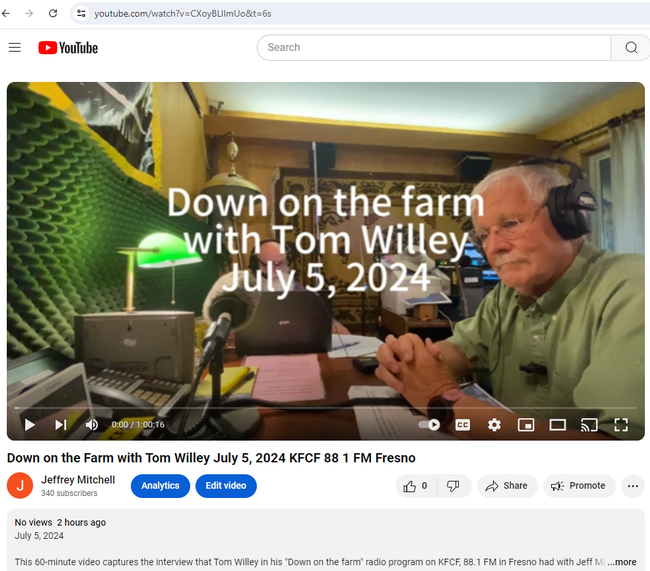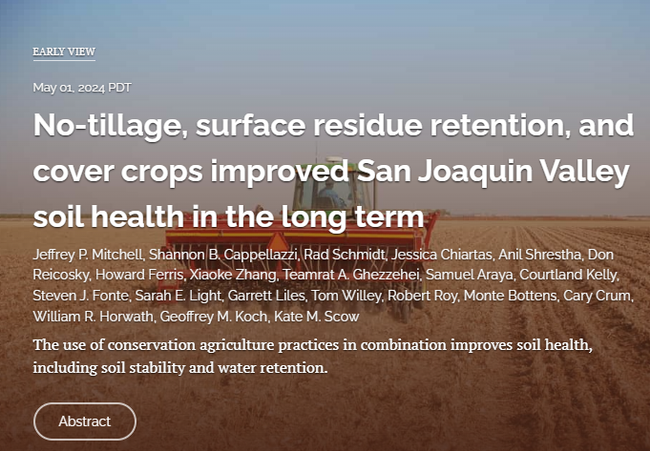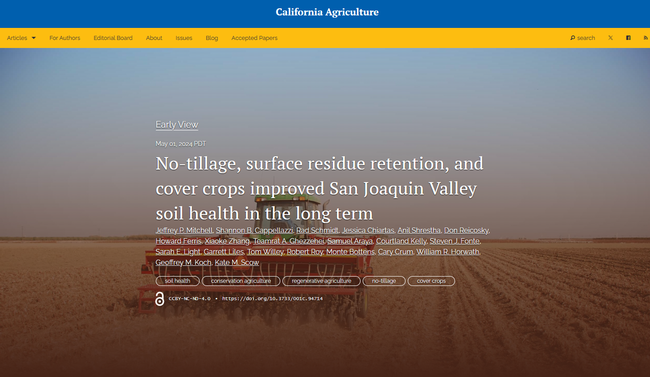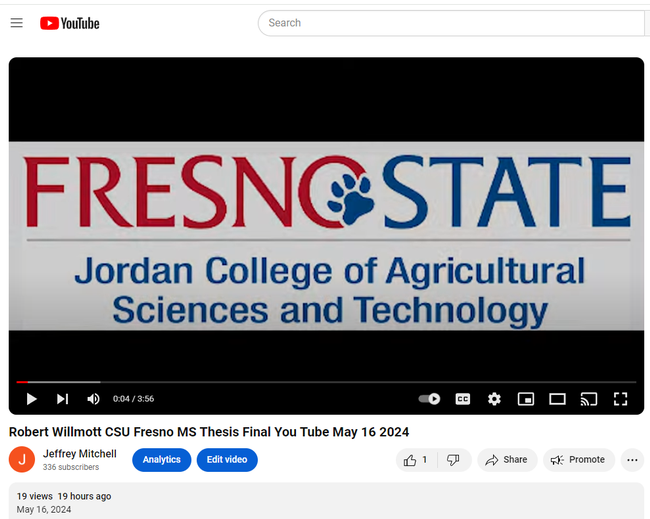- Author: Jeffrey P Mitchell
July 5, 2024
CASI's Jeff Mitchell was a "three-peater" July 5th on Tom Willey's "Down on the farm" radio program on KFCF's 88.1 FM station on July 5, 2024. He shared information from the recently published article, No-tillage, surface residue retention, and cover crops improved San Joaquin Valley soil health in the long term, that was published in the May 2024 issue of California Agriculture. Willey was a co-author on the work and he talked with Mitchell about how the work came about, what its study goals were, how it was conducted, and what its findings were. Willey's program airs every first Friday of the month and has a loyal following that includes a great diversity of folks who greatly enjoy his 'on the front porch' conversations with his guests. A video of the radio interview is available at the You Tube link
https://www.youtube.com/watch?v=CXoyBLlImUo

- Author: Jeffrey P Mitchell
CASI's Mitchell on MyAgLife podcast June 28, 2024
July 1, 2024
Jeff Mitchell, CASI member and Professor and Cropping Systems Cooperative Extension Specialist in the Department of Plant Sciences at the University of California, Davis, appeared in a 39-minute podcast with host Taylor Chalstrom on June 28, 2024 to talk about conservation agriculture in general and the recently-published article in California Agriculture on the 20-year study in Five Points, CA. The podcast is available at
https://spotifyanchor-web.app.link/e/JuQ7qakGSKb
You may need the podcast platform, Spotify, to listen to it.

- Author: Jeffrey P Mitchell
In an effort to extend information on CASI's twenty-year conservation agriculture study that has been conducted at the University field station in Five Points, CA and that has been recently published in the journal, California Agriculture, Jeff Mitchell provided three radio interviews on the morning Ag Report that Don York produces for KMJ580 AM each morning out of Fresno. The segments aired on May 23rd and on June 4th and 6th, 2024 and are available below. Mitchell shared findings of the long-term “NRI Project” that since 1998 has examined four production systems – standard tillage without cover crop, standard tillage with cover crop, no-till without cover crop, and no-till with cover crop.
The NRI Project started as an effort to determine the potential of reduced disturbance tillage in terms of generating or producing less dust and in the early 2000s found that dust can be significantly reduced by as much as 80% with a variety of reduced tillage practices relative to standard tillage techniques that have been widely used in annual crop fields throughout the San Joaquin Valley since the early 1930s. The recent findings from the unique long-term study have shown that several soil health indicators including aggregation, water infiltration, biodiversity, and surface carbon were improved through the long-term use of cover crops with reduced disturbance tillage.
In the interviews, Mitchell points out that the systems that were evaluated and developed in the NRI Project were not at all easy to implement and required considerable trial-and-error effort to achieve. Yields, for instance, of cotton in the early years under the high residue, no-till cover crop system lagged behind the standard tillage, however once effective planting techniques were learned to establish the cotton crop. There were no yield differences between the two tillage systems for the next several years.
The results of this study that included 18 coauthors can be seen at https://doi.org/10.3733/001c.94714
Jeff Mitchell on KMJ Ag Report 5-23-24
Jeff Mitchell on KMJ Ag Report 6-4-24
Jeff Mitchell on KMJ Ag Report 6-6-24

- Author: Jeffrey P Mitchell
May 17, 2024
Findings from twenty years of soil health research in Five Points, CA have been published in the University of California's California Agriculture peer-reviewed journal's May 1, 2024 issue. https://doi.org/10.3733/001c.94714.
This work has been a large collaborative effort involving twenty-one UC and non-UC coauthors. It began in 1998 initially as an effort to evaluate the potential of reduced disturbance tillage systems to reduce dust emissions from annual cropping systems that are common in California's San Joaquin Valley. It long-term nature however, allowed it to become a unique site for also monitoring changes in soil properties and function under four experimental systems: conventional tillage with no cover crop, conventional tillage with cover crop, no-till with no cover crop, and no-till with cover crop. Crops rotated between tomato and cotton initially, but later during the study, the rotation was diversified to include melons, sorghum, and garbanzo beans.
The work involved the Soil Health Institute's Shannon Cappellazzi, who sampled at the site in 2019. That sampling event led to the site becoming part of a multiple-publication series of articles that reported on soil health impacts in 124 long-term study sites across North America.
https://soilhealthinstitute.org/news-events/a-minimum-suite-of-soil-health-indicators-for-north-american-agriculture/

- Author: Jeffrey P Mitchell
Robert Willmott not only recently wrapped up his MS thesis research at Fresno State, but he also works full-time as the Farm Manager for his college's student ag farm, is married, and has two small children as well! A full plate, to say the least. In addition to all this, he recently told his story at Fresno State in a 3-minute video that is now posted at You Tube https://www.youtube.com/watch?v=Uo6xZh5sGdA
Working in the Department of Plant Science in the Jordan College of Agricultural Sciences and Technology under his award-winning and Fellow in the American Society of Agronomy major professor, Anil Shrestha, Robert presented his thesis work in an exit seminar on May 14th on campus ahead of being awarded this MS and graduating later this month. His work consisted of a multiple-year study to evaluate the potential of using a roller crimper and strip-tillage for producing silage corn under center pivot irrigation, a new systems approach for San Joaquin Valley dairies that rely on winter and corn silage for animal feed materials. The several years of the study saw quite good success in terminating a variety of winter cover crop mixes using the roller crimper, strong weed suppression during the early corn season, and corn yields comparable to industry standards and the conventional control system that was part of the evaluation.
The work is now being prepared for submission to a scientific journal later this summer. A three-minute You Tube video summarizing Robert's work may be viewed at the link https://www.youtube.com/watch?v=Uo6xZh5sGdA




